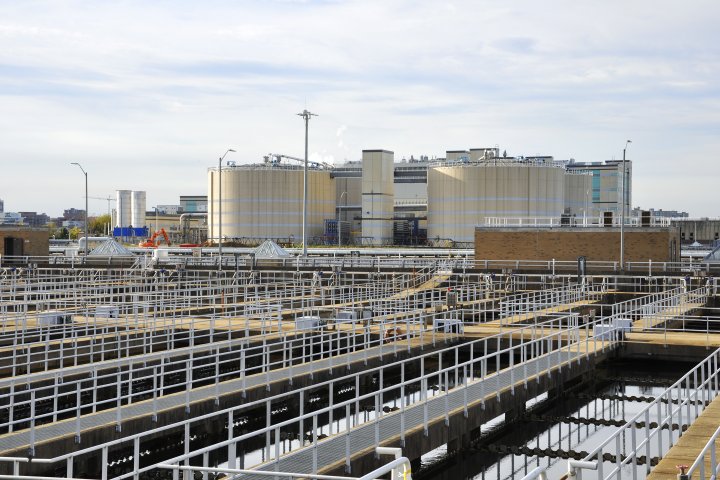這家公司將城市污水變廢為寶

|
美國的華盛頓特區(qū)水務(wù)部門的廢水處理設(shè)施每天都要處理1500噸廢水。該部門的CEO喬治?霍金斯將這些廢水看作“液體黃金”,。這是一項(xiàng)相當(dāng)賺錢的業(yè)務(wù),,賺來的利潤可以幫助該部門修理其老化的基礎(chǔ)設(shè)施。他領(lǐng)導(dǎo)的DC Water部門主要負(fù)責(zé)對(duì)廢水進(jìn)行處理,、消毒,,然后將其轉(zhuǎn)化成一種名叫Bloom的土壤肥料。從今年春天起,,這種肥料已經(jīng)開始向該地區(qū)的苗圃和花卉商店供應(yīng),。 一想到下水道的廢水,很多人都會(huì)有作嘔的沖動(dòng),。但通過創(chuàng)新廢水處理方式來省錢或賺取利潤的機(jī)構(gòu)遠(yuǎn)不止DC Water這一家,。比如費(fèi)城的公用事業(yè)部門就將暴雨時(shí)沖進(jìn)下水道的水儲(chǔ)存起來,用于公園的綠化灌溉,。而在俄勒岡州的波特蘭市,,凈化的廢水已經(jīng)被用來釀造啤酒了。(當(dāng)然,,沒人強(qiáng)迫你非得喝這種啤酒,。) 華盛頓水務(wù)部門的廢水處理計(jì)劃可謂雄心勃勃,,整個(gè)過程首先從沖馬桶開始。DC Water在全城擁有1800英里長的下水道,,你家馬桶的水會(huì)經(jīng)由其中的一根管道匯入該部門的污水處理廠,。其中的油脂、脂肪,、沉積物和雜質(zhì)會(huì)被過濾掉,,過濾后的水會(huì)被消毒,而過濾出的污泥則要經(jīng)過高溫高壓,、消毒,、軟化等三個(gè)步驟的處理,隨后這些干凈的淤泥會(huì)被送入一個(gè)厭氧的沼氣池中,。在那里,,它們會(huì)被巨大的攪拌機(jī)攪拌兩周的時(shí)間,使一種叫做“產(chǎn)甲烷菌”的微生物分解掉淤泥中的有機(jī)物,,從而產(chǎn)生用于發(fā)電的沼氣,。這些沼氣發(fā)出的電力可滿足該污水處理廠三分之一的生產(chǎn)用電。剩下的淤泥會(huì)被帶式壓濾機(jī)再次擠壓,,排出其中的水分,。然后它們會(huì)被填進(jìn)堆放肥料的大坑中儲(chǔ)藏,每個(gè)大坑可儲(chǔ)藏1000噸這樣的污水加工肥料,。 這些肥料可以用于給花園和樹木施肥,。(據(jù)在華盛頓地區(qū)經(jīng)營Homestead Gardens花卉商店的布萊恩?里德爾稱,市場對(duì)Bloom牌的肥料有著很高的需求,。他表示,,市面上很難找到像Bloom肥料這樣既物美價(jià)廉、又安全天然的肥料,。他說:“Bloom肥料富含各種有價(jià)值的營養(yǎng)物質(zhì),。”) DC Water已經(jīng)花費(fèi)了好幾年時(shí)間對(duì)這項(xiàng)技術(shù)進(jìn)行研究和測試,。之前這項(xiàng)技術(shù)已經(jīng)在歐洲得到了應(yīng)用。兩年前,,DC Water斥資4.7億美元訂購了相關(guān)設(shè)備,。何況就算不購買這些設(shè)備,DC Water遲早也得把這筆錢盡數(shù)花在廢水處理上,。而這種處理方法不僅具有可持續(xù)性,,還可以產(chǎn)生不少的收益,這筆錢則可以用來維修老舊的污水管道,。DC Water的下水道大半都使用了79年以上,,有些甚至是1860年修建的,。據(jù)該部門預(yù)計(jì),未來幾年,,他們至少要花費(fèi)10億美元用來維修這些管道,。 目前,Bloom肥料的銷售仍然處于起步階段,,霍金斯表示,,Bloom品牌可能還需要兩三年才能初具規(guī)模。但這種模式顯然是必要的,?!拔覀兙拖褚患覄?chuàng)業(yè)公司一樣,如果我們不進(jìn)行根本性的改革,,我們的業(yè)務(wù)模式就必然會(huì)失敗,。” 美國土木工程師協(xié)會(huì)的前任主席格雷格?迪雷奧托指出,,美國大部分的基礎(chǔ)設(shè)施可能都面臨著類似DC Water的境地,。美國土木工程師協(xié)會(huì)每四年會(huì)發(fā)布一份關(guān)于美國基建設(shè)施現(xiàn)狀的報(bào)告。今年的報(bào)告給美國的基礎(chǔ)設(shè)施打出了D+的分?jǐn)?shù),。美國各地有14748個(gè)水處理設(shè)施尤其亟須維修,,全美每年破裂的污水管道達(dá)到了24萬根,。而且迪雷奧托指出,,未來20年,這些設(shè)施還得額外為5600萬名新用戶服務(wù),。 迪雷奧托也表揚(yáng)了DC Water的創(chuàng)新:“這種創(chuàng)新會(huì)使資金發(fā)揮更大的效用,。但我們?nèi)孕枰M(jìn)一步的投資,,否則我們就會(huì)看到更多的污水管道破裂,,遭遇更多的密歇根州弗林特市發(fā)生過的那種飲水危機(jī),。” 歸功于這筆新投資,,目前DC Water的運(yùn)營預(yù)算已經(jīng)有所削減,,它的生物廢料和能源成本也同樣有所下降,,同時(shí)它也成了華盛頓地區(qū)最大的清潔能源發(fā)電企業(yè)。該部門還制定了更多的計(jì)劃來增加收入,,比如銷售“廢水熱能”——該技術(shù)可以利下水道系統(tǒng)安裝的熱交換器來對(duì)建筑物提供冷氣或采暖,,原理很像傳統(tǒng)的地?zé)崮堋T谙驖撛诳蛻敉茝V之前,,DC Water已經(jīng)開始在自己的幾棟辦公樓里進(jìn)行試驗(yàn)了,。他們的這些創(chuàng)新做法也給“儉以防匱”這句老話賦予了新的意義,。(財(cái)富中文網(wǎng)) 譯者:樸成奎 |
The water authority in Washington, D.C., receives 1,500 wet tons of sewage into its wastewater-treatment facility each day. CEO George Hawkins views it as liquid gold—an ingredient for a moneymaking operation that could help pay for repairs to its aging infrastructure. His agency, DC Water, cooks, sterilizes, and turns that sewage into a soil fertilizer called Bloom, which began shipping this spring to nurseries and garden centers in the region. Ignore the “ick” ?factor. DC Water is among a handful of utilities that is innovating to save or generate money. Philadelphia’s utility is using the water that washes into the sewers during storms to keep its parks green. And in Portland, Ore., purified wastewater is being used to make beer. (No one says you have to drink it.) The Washington initiative is ambitious. The process begins with the matter flushed down a toilet, which may travel through any of DC Water’s 1,800 miles of sewer pipes to the wastewater-treatment plant. Oils, fats, sediments, and objects are screened out, and the water is disinfected. The remaining sludge then goes through a three-stage process that cooks it in high heat and pressure, sterilizing and softening it. The clean sludge is then sent to four 80-foot-tall anaerobic digesters, where giant mixers churn the liquid for two weeks while a population of microorganisms called “methanogens” eats the organic matter, producing methane gas for electricity that ultimately powers a third of the water plant’s operations. The solids then travel to a belt-filter press that squeezes out water and delivers the crumbly compost to bunkers that can hold 1,000 tons each. The result can be used to fertilize gardens and trees. (Bloom fertilizer is in high demand, says Brian Riddle, who bought 1,000 tons of it for his D.C.-area garden centers, Homestead Gardens. He says it’s hard to find affordable fertilizer that’s safe and natural. “Bloom,” he says, “is loaded with valuable nutrients.”) DC Water spent several years investigating and testing the technology, which was already in use in Europe, before spending $470 million on the equipment two years ago. DC Water would have needed to spend most of that money anyway to treat the biosolids, and this was a way to do that in a sustainable manner and generate revenue to fix aging pipes. More than half of the D.C. pipes are 79 years or older—some date to 1860—and the agency estimates a need for at least $1 billion in repairs in the coming years. Bloom’s sales are still fledgling, and Hawkins says it may take two or three years to ramp up. But the approach was a necessity. “It’s literally like a startup,” he says. “Our business model was going to fail without fundamental change.” That could be the case for much of America’s broad array of infrastructure, says Greg DiLoreto, past president of the American Society of Civil Engineers, which produces a report card on the state of the nation’s infrastructure every four years. America’s grade this year: D+. The nation’s 14,748 water-treatment facilities are in particular disrepair, suffering from 240,000 pipe breaks a year. Those facilities will need to serve some 56 million new customers over the next two decades, says DiLoreto. He praises DC Water’s initiative. “That kind of innovation will make the money go a lot further,” says DiLoreto, “but we still need investment or we’re going to see more pipe breaks and more Flint, Michigans.” DC Water’s new investment has allowed it to cut its operating budget, as well as its biosolid disposal and energy costs, making it the largest generator of clean energy in the Washington, D.C., area. The utility has even more plans to generate revenue, including selling “sewer-thermal energy,” which uses heat exchangers inside the city’s underground sewage system to heat and cool buildings—much like traditional geothermal energy drawn from the earth’s core. The sewer energy is being tested at several of DC Water’s own buildings before being rolled out to potential customers. Other plans are in the works too. They give new meaning to the old phrase “Waste not, want not.”? |













